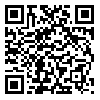دوره 19، شماره 1 - ( 1-1400 )
جلد 19 شماره 1 صفحات 30-23 |
برگشت به فهرست نسخه ها
Download citation:
BibTeX | RIS | EndNote | Medlars | ProCite | Reference Manager | RefWorks
Send citation to:



BibTeX | RIS | EndNote | Medlars | ProCite | Reference Manager | RefWorks
Send citation to:
Safarpour L, Jalilevand N, Ghorbani A, Rasouli M, Bayazian G. Language Sample Analysis in Children With Cleft Lip and Palate. Iranian Rehabilitation Journal 2021; 19 (1) :23-30
URL: http://irj.uswr.ac.ir/article-1-1132-fa.html
URL: http://irj.uswr.ac.ir/article-1-1132-fa.html
Language Sample Analysis in Children With Cleft Lip and Palate. مجله انگلیسی زبان توانبخشی. 1400; 19 (1) :23-30
چکیده: (5276 مشاهده)
Objectives: Cleft Palate (CP) with or without Cleft Lip (CL/P) are the most common craniofacial birth defects. Cleft Lip and Palate (CLP) can affect children’s communication skills. The present study aimed to evaluate language production skills concerning morphology and syntax (morphosyntactic) in children with CLP.
Methods: In the current cross-sectional study, 58 Persian-speaking children (28 children with CLP & 30 children without craniofacial anomalies=non-clefts) participated. Gathering the language samples of the children was conducted using the picture description method. The 50 consecutive intelligible utterances of children were analyzed by the Persian Developmental Sentence Scoring (PDSS), as a clinical morphosyntactic measurement tool.
Results: The PDSS total scores of children with CLP were lower than those of the non-clefts children. A significant difference was found between the studied children with CLP and children without craniofacial anomalies in the mean value of PDSS total scores (P=0.0001).
Discussion: Children with CLP demonstrate a poor ability for using morphosyntactic elements. Therefore, it should be considered how children with CLP use the grammatical components.
Methods: In the current cross-sectional study, 58 Persian-speaking children (28 children with CLP & 30 children without craniofacial anomalies=non-clefts) participated. Gathering the language samples of the children was conducted using the picture description method. The 50 consecutive intelligible utterances of children were analyzed by the Persian Developmental Sentence Scoring (PDSS), as a clinical morphosyntactic measurement tool.
Results: The PDSS total scores of children with CLP were lower than those of the non-clefts children. A significant difference was found between the studied children with CLP and children without craniofacial anomalies in the mean value of PDSS total scores (P=0.0001).
Discussion: Children with CLP demonstrate a poor ability for using morphosyntactic elements. Therefore, it should be considered how children with CLP use the grammatical components.
نوع مقاله: گزارش کوتاه |
موضوع مقاله:
گفتار درمانی
دریافت: 1398/11/6 | پذیرش: 1400/1/10 | انتشار: 1400/1/10
دریافت: 1398/11/6 | پذیرش: 1400/1/10 | انتشار: 1400/1/10





